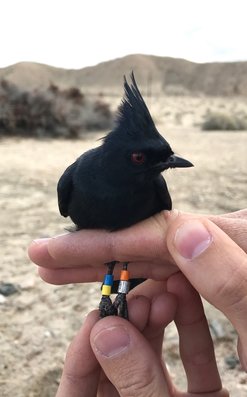ITINERANT BREEDING IN THE PHAINOPEPLA
|
Migratory birds generally divide the annual cycle between discrete breeding and non-breeding ranges. Itinerant breeders, however, reproduce twice at different geographic locations, migrating between them. This unusual flexibility in movement ecology and breeding biology suggests that some species can rapidly modulate the conflicting physiological and behavioral traits required for migration and reproduction. The Phainopepla (Phainopepla nitens), a songbird of the southwestern USA, has long been suspected to breed first in desert habitats in spring, then migrate to woodland habitats to breed again in summer. However, direct evaluation of movement and gene flow among individuals breeding in different locations has previously been logistically intractable. We deployed GPS tags on free-flying Phainopeplas in southern California, all of which migrated to hypothesized woodland breeding habitats after desert breeding (an average distance of 232 km). GPS data also revealed previously unknown fall and spring stopover sites. Population genomic analyses revealed no genetic differentiation among desert and woodland breeding populations, indicating significant movement and gene flow across the region. Finally, we used random forest analyses to quantify substantial environmental differences among temporal stages. Our results provide direct evidence that individual Phainopeplas do indeed move between two drastically different breeding habitats in the same year, representing a rare and extreme example of life-history flexibility.
|

